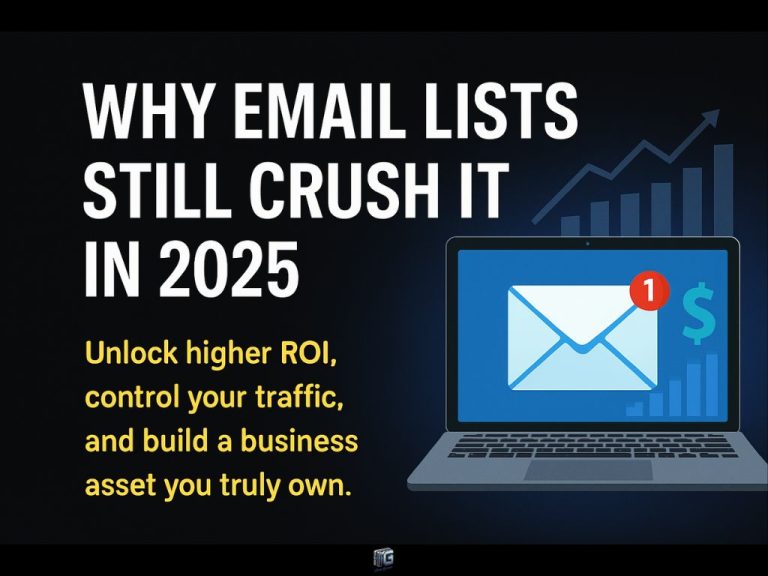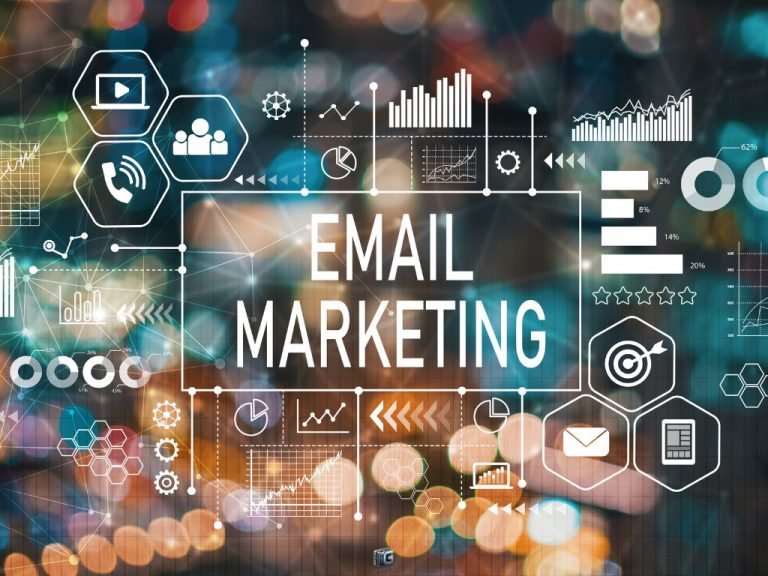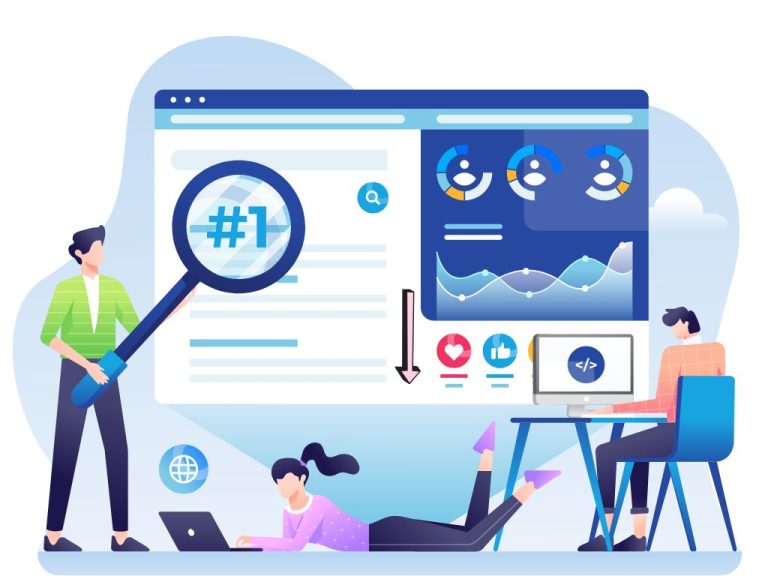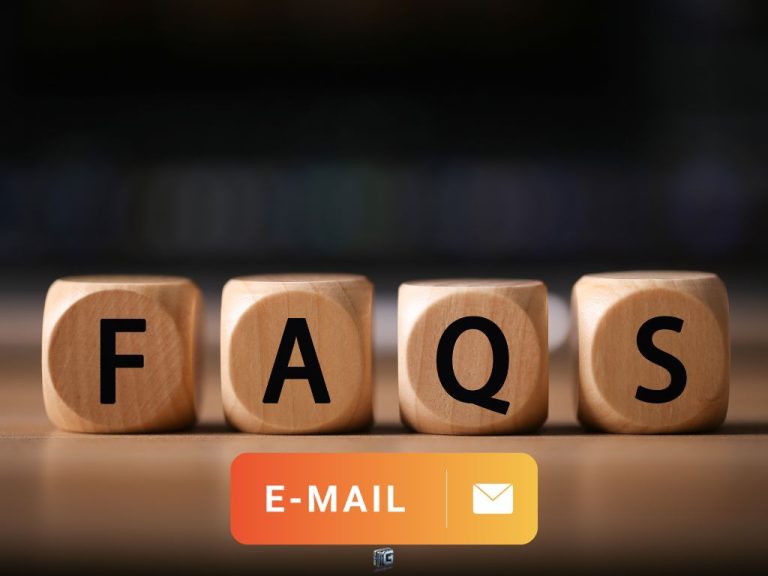Introduction
If you’re building an online business in 2025 whether it’s through affiliate marketing, coaching, or selling digital products one tool consistently outperforms the rest: your email marketing list.
While social media reach fluctuates and advertising costs continue to rise, email gives you something no other platform can: direct, personal access to your audience that you own and control.
An email list isn’t just a marketing channel, it’s a long-term business asset that drives consistent traffic, builds trust, and delivers high returns.
In this guide, we’ll break down exactly what an email marketing list is, why it’s still one of the most powerful tools in digital marketing, and how to build and use your list to grow your business.
Next, read our Ultimate Email Marketing Guide before you start.

Key Takeaways: Why Email Marketing Lists Still Matter
- An email marketing list gives you full control over how and when you communicate with your audience no algorithms, no gatekeepers.
- Email remains one of the highest-performing digital marketing channels, with potential returns of up to $42 for every $1 spent.
- Lists allow for personalized, segmented messaging, leading to higher open rates, stronger engagement, and more conversions.
- You can use email to drive traffic back to your website, boost affiliate commissions, and support product launches or promotions.
- Unlike social platforms, your list is a business asset you own, it’s not affected by external platform changes or ad policy shifts.
- With detailed analytics like open rates and click-throughs, email marketing is easy to measure, optimize, and scale over time.
What Is an Email Marketing List?
An email marketing list is a collection of email addresses that people have voluntarily given you typically through a form on your website, landing page, or social platform in exchange for updates, resources, or exclusive content.
This list becomes your direct line to potential customers, allowing you to:
- Send updates about your products, content, or services
- Promote affiliate offers or digital products
- Build trust and nurture leads over time
Unlike social media followers or ad audiences, your email list is an owned asset. You control how and when you reach your subscribers, and you’re not at the mercy of third-party platforms, policy changes, or fluctuating algorithms.
In digital and affiliate marketing, an email list isn’t just a nice-to-have, it’s a core part of building a business that’s sustainable, scalable, and profitable.

Reason 1: Why Email Marketing List Still Work
Reach Your Audience with Direct, Personal Messaging
One of the biggest advantages of building an email marketing list is the ability to connect with your audience directly and personally. Unlike social media platforms, where reach is controlled by algorithms, email gives you guaranteed access to your subscribers’ inboxes.
This makes your message more likely to be seen, opened, and acted on.
Email marketing platforms also allow you to:
- Segment your list based on behavior or interests
- Personalize emails using the subscriber’s name or preferences
- Automate follow-ups based on specific actions (like clicking a link or downloading a lead magnet)
This level of targeting and personalization leads to stronger relationships, higher engagement, and better conversion rates.
If you’re building trust and long-term value, email is still one of the most effective ways to deliver the right message to the right person at the right time.
Reason 2: Why Email Marketing List Still Work
Get the Highest ROI Without Spending Big
Email marketing consistently ranks as one of the most cost-effective digital strategies. It offers a high return on investment (ROI), especially when compared to paid ads or social media promotions.
Industry benchmarks show that email marketing can generate up to $42 for every $1 spent and in many niches, especially affiliate marketing and digital products, that number can be even higher.
Here’s why email is so efficient:
- Low platform costs (many tools are free or start under $30/month)
- You can reach thousands of people without paying per click or impression
- Once built, your list becomes a reusable asset for ongoing promotions
For digital marketers and affiliate creators, this means you can promote multiple offers, products, or content pieces using the same list without constantly reinvesting in traffic.
Whether you’re just starting out or optimizing a growing business, building an email list is one of the smartest ways to stretch your budget while scaling your income.
Reason 3: Why Email Marketing List Still Work
Turn Every Email into Targeted Website Traffic
An email list isn’t just a communication tool, it’s a reliable traffic engine that brings subscribers back to your website, content, and offers on a consistent basis.
Every email you send can direct readers to:
- Blog posts and articles
- Product pages or affiliate links
- Landing pages for lead magnets or webinars
- Special promotions, sales, or new launches
Because your audience has already opted in, they’re more likely to click, engage, and convert compared to cold traffic from ads or search.
The result?
You’re not just driving page views, you’re generating targeted traffic with high buying intent.
For affiliate marketers, this means:
- More clicks on your product links
- Higher conversion rates due to trust
- Ongoing sales from existing subscribers
Over time, this repeat traffic adds up to scalable, compounding growth especially when paired with strong content and compelling calls to action.
Reason 4: Why Email Marketing List Still Work
Strengthen Customer Loyalty with Ongoing Value
Building an email marketing list isn’t just about acquiring new leads, it’s about keeping the right people engaged over time. Consistent, value-driven emails build loyalty, create familiarity, and strengthen the bond between your brand and your audience.
When subscribers regularly hear from you and benefit from your insights, recommendations, or exclusive offers, they begin to trust you. That trust turns into repeat engagement, repeat clicks, and repeat purchases.
Here’s what email does for customer loyalty:
- Keeps your brand top-of-mind between purchases or launches
- Allows you to deliver personal follow-ups, thank-you emails, and exclusive perks
- Nurtures new leads into buyers, and buyers into loyal fans
In affiliate marketing, this trust translates directly into more conversions. People are more likely to purchase through your links when they believe in the value you bring not just the product you promote.
A strong email list doesn’t just help you make a sale. It helps you build a business that people come back to again and again.
Reason 5: Why Email Marketing List Still Work
Stop Relying on Platforms You Don’t Control
Social media platforms come and go. Algorithms change. Accounts get shadowbanned, throttled, or even deleted. But your email marketing list is something you own and that changes everything.
When you rely solely on platforms like Instagram, TikTok, or Facebook, you’re building on rented land. One policy update or algorithm tweak can instantly cut your reach in half.
But with an email list:
- You own your audience no middleman, no interference
- You control when and how your message is delivered
- Your content isn’t filtered or hidden by external systems
This independence is critical for long-term stability, especially if you’re running a content-based business, promoting affiliate offers, or launching products.
Your email list becomes your most reliable, future-proof marketing channel a direct line to your customers that no platform can take away.
Reason 6: Why Email Marketing List Still Work
Use Real-Time Data to Optimize Every Campaign
One of the biggest advantages of using an email marketing list is that everything is trackable. You get clear data that tells you what’s working, what’s not, and how to improve your results over time.
Most email platforms provide detailed analytics, including:
- Open rates: how many people are engaging with your subject lines
- Click-through rates: which content or offers are driving interest
- Unsubscribe rates: whether your messaging is resonating
- Conversion tracking: what actions your subscribers take after clicking
With this data, you can:
- A/B test subject lines, calls to action, or content formats
- Segment your audience based on engagement behavior
- Improve future campaigns based on real-world performance
Unlike guesswork-based marketing, email gives you a feedback loop that leads to smarter strategy, better targeting, and higher revenue over time.
It’s not just about sending emails. It’s about refining your system, learning what your audience responds to, and scaling your results strategically.

How to Start and Grow Your Email List
Building an email list from scratch might feel overwhelming but with the right steps and tools, it’s one of the most effective and scalable things you can do for your online business.
Whether you’re an affiliate marketer, course creator, or content publisher, here’s how to get started:
1. Choose an Email Marketing Platform
Your first step is selecting a beginner-friendly email service provider (ESP) that offers automation, segmentation, and analytics. Popular options include:
- ConvertKit – Great for creators and affiliate marketers
- Mailchimp – Good for basic lists and visual builders
- AWeber – Solid for small business owners
- GetResponse – Feature-rich with landing pages and automation
- Systeme.io – All-in-one platform, perfect for new marketers
Pick a tool that fits your budget and growth goals. Most offer free plans to start.
2. Create a Lead Magnet That Solves a Problem
To get people to join your list, you need to offer value in exchange for their email. That’s where a lead magnet comes in.
Great lead magnets include:
- Free checklists or templates
- Quick-start guides
- Resource lists
- Mini email courses
- Discount codes or exclusive access
The key is solving a specific problem your audience has, fast.
3. Use High-Converting Opt-In Forms
Add email opt-in forms where your audience is most active, such as:
- Homepage or blog sidebar
- Pop-ups or slide-ins
- End of blog posts
- Landing pages from social media or YouTube
Make sure your copy is clear, benefit-focused, and includes a strong call-to-action.
4. Promote Your List Through Content and Channels You Own
Driving traffic to your email list is an ongoing process. Use:
- Blog content with embedded opt-ins
- YouTube videos with lead magnet CTAs
- Instagram Stories or bio links
- Pinterest pins linking to opt-in pages
- Guest posts or podcast appearances
Always link back to your lead magnet or signup form in your content strategy.
5. Start Nurturing With Automated Sequences
Once someone joins your list, don’t leave them hanging.
Set up a simple email sequence to:
- Welcome new subscribers
- Deliver your lead magnet
- Introduce your brand or story
- Share helpful content
- Recommend affiliate offers or products
Automation ensures every subscriber gets a consistent, high-value experience without manual work.

Email Marketing Lists: Common Mistakes to Avoid
Growing an email marketing list is one thing maintaining a healthy, engaged list is another. Many beginners make simple mistakes that reduce deliverability, hurt engagement, or even violate email marketing best practices.
Avoid these common pitfalls to protect your reputation and improve results:
1. Buying or Scraping Email Lists
Never purchase email lists or use third-party tools to scrape emails. These contacts haven’t opted in, which means:
- You’ll likely violate spam laws (like GDPR or CAN-SPAM)
- Your open and click rates will be low
- Your sender reputation may suffer, leading to blacklisting
Always build your list organically by offering real value.
2. Ignoring Segmentation
Sending the same message to your entire list can lead to:
- Higher unsubscribe rates
- Lower engagement
- Missed opportunities for targeted offers
Even basic segmentation like separating new subscribers from long-term ones can lead to better open rates and more relevant content delivery.
3. Inconsistent Email Frequency
If you email too often, you risk annoying your subscribers. If you wait too long between emails, they may forget who you are.
The fix: Be consistent.
Whether it’s once a week or twice a month, choose a schedule and stick to it so your audience knows what to expect.
4. Sending Value-less Content or Only Sales Pitches
If every email you send is a pitch, your list will stop opening or start unsubscribing.
Focus on delivering:
- Educational content
- Helpful resources
- Exclusive tips
- Occasional promotions (with clear value)
Aim for an 80/20 balance: 80% value, 20% promotion.
5. Failing to Optimize for Mobile
Over 60% of emails are opened on mobile devices. If your emails don’t display correctly on a phone, you’ll lose readers fast.
Always:
- Use mobile-responsive templates
- Keep subject lines short
- Use clear formatting with plenty of white space

Email Marketing Lists: Recommended Tools and Resources
To build and manage an effective email marketing list, you’ll need the right tools. Below is a curated list of beginner-friendly platforms and resources that support every stage of your email marketing journey from capturing leads to nurturing and converting them.
1. Email Marketing Platforms
These services help you collect emails, send broadcasts, create automations, and track performance.
- ConvertKit – Built for creators and affiliate marketers; simple automations and segmentation.
- MailerLite – Affordable and intuitive with strong visual email design tools.
- GetResponse – All-in-one tool with autoresponders, landing pages, and webinar tools.
- Systeme.io – Free to start, includes email, funnels, and course hosting ideal for beginners.
- AWeber – Solid reputation, good for small businesses looking for reliability.
2. List-Building Tools and Lead Capture
These tools help you create high-converting opt-in forms and landing pages.
- OptinMonster – Advanced targeting and A/B testing for popups and forms.
- Thrive Leads – Great for WordPress users looking for customization and integrations.
- ConvertBox – Smart behavior-based popups and segmentation.
- LeadPages – Easy-to-use landing page builder with conversion-focused templates.
3. Lead Magnet Creation Tools
Use these to design lead magnets that attract the right subscribers.
- Canva – Create checklists, guides, or PDFs with drag-and-drop ease.
- Beacon – Specifically designed for creating lead magnets like resource guides or ebooks.
- Google Docs + PDF Export – Simple and free for quick-start lead magnets.
4. Email Templates and Swipe Files
Save time and improve engagement with proven frameworks.
- Pre-built welcome sequences (offered by most platforms)
- Copywriting swipe files from marketers like Alex Cattoni or Copyhackers
- [Your Brand’s Free Email Starter Pack] (Insert actual link to resource)

Frequently Asked Questions About Email Marketing Lists
What is an email marketing list?
An email marketing list is a collection of email addresses from individuals who have opted in to receive content, updates, or promotions from your business. It’s one of the most effective ways to build relationships, promote offers, and grow online revenue.
How do I start building an email list from scratch?
Start by choosing an email platform like ConvertKit, MailerLite, or Systeme.io. Then create a lead magnet like a free guide or checklist and promote it using a landing page, blog post, YouTube video, or social media bio link. Make sure your opt-in forms are easy to find and clearly explain the value.
How often should I email my list?
Consistency matters more than frequency. For most businesses, once a week or every other week is ideal. Avoid long gaps between emails, but don’t overload your list with too many promotions. A consistent rhythm builds trust and keeps engagement high.
Is email marketing still effective in 2025?
Yes, more than ever. Despite the rise of social media, email remains one of the highest-performing marketing channels. You own the audience, control the timing, and can deliver highly personalized content that converts better than most other traffic sources.
What should I send to my email list?
Focus on providing value. This can include blog updates, tips, how-to guides, curated resources, special offers, affiliate product recommendations, or personal insights. A good rule of thumb: 80% value-driven content, 20% promotion.

Conclusion: Your Email List Is Your Most Valuable Asset
In an online world filled with distractions, changing algorithms, and rising ad costs, your email marketing list is the one thing you truly own and control. It’s more than a marketing channel, it’s a long-term business asset that grows with you.
To recap:
- Email gives you direct, personal access to your audience.
- It delivers some of the highest ROI in digital marketing.
- It drives traffic, builds loyalty, and converts leads into sales.
- You’re in control no algorithms, no middlemen.
- You get real data to improve performance over time.
If you’re not building your list, you’re building someone else’s platform. The sooner you start growing your email list, the sooner you create freedom, stability, and scalable income for your business.
Check out our Ultimate Guide to master your email marketing efforts today! 🚀
